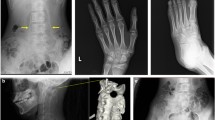Abstract
Fibrodysplasia ossificans progressiva (FOP; OMIM 135100) is a rare heritable disorder of connective tissue characterized by congenital malformations of the great toes and recurrent episodes of painful soft tissue swelling that lead to heterotopic ossifications. Recent studies have shown that the ACVR1 (activin A receptor, type I; OMIM 102576) gene, which encodes the BMP type I receptor protein, is responsible for this disease. We observed two Chinese patients who suffered from progressive pain and ankylosis of major joints with congenital bilateral hallus valgus malformation, neck stiffness, and several posttraumatic ossified lesions on the head and dorsum. Both patients were diagnosed as having FOP. This study aimed to investigate the ACVR1 gene mutation in Chinese FOP patients. Direct sequence analysis of genomic DNA and restriction enzyme digestion demonstrated the presence of a single heterozygous c.617G>A (p.R206H) mutation in the ACVR1 gene in both patients. This mutation is first reported in Chinese patients with FOP and it was de novo in both affected families.



Similar content being viewed by others
References
Kaplan FS, Shore EM, Connor JM (2002) Fibrodysplasia ossificans progressiva (FOP). In: Royce PM, Steinmann B (eds) Connective tissue and its heritable disorders: molecular, genetic, and medical aspects, 2nd edn. Wiley-Liss, New York, pp 827–840
Connor JM, Evans DAP (1982) Genetic aspects of fibrodysplasia ossificans progressiva. J Med Genet 19:35–39
Shore EM, Xu M, Feldman GJ, Fenstermacher DA, Brown MA, Kaplan FS (2006) A recurrent mutation in the BMP type I receptor ACVR1 causes inherited and sporadic fibrodysplasia ossificans progressiva. Nat Genet 38:525–527
Lin GT, Chang HW, Liu CS, Huang PJ, Wang HC, Cheng YM (2006) De novo 617G>A nucleotide mutation in the ACVR1 gene in a Taiwanese patient with fibrodysplasia ossificans progressiva. J Hum Genet 51:1083–1086
Nakajima M, Haga N, Takikawa K, Manabe N, Nishimura G, Ikegawa S (2007) The ACVR1 617G>A mutation is also recurrent in three Japanese patients with fibrodysplasia ossificans progressiva. J Hum Genet 52:473–475
Hao Z, Dadi J, Zongsen J, Hanqing W (2002) Myositis ossificans progressiva (MOP): literature review of 51 MOP cases in China. Chin J Clin Rehabil 22:3384–3385
Schaffer AA, Kaplan FS, Tracy MR, O’Brien ML, Dormans JP, Shore EM, Harland RM, Kusumi K (2005) Developmental anomalies of the cervical spine in patients with fibrodysplasia ossificans progressiva are distinctly different from those in patients with Klippel-Feil syndrome: clues from the BMP signaling pathway. Spine 30:1379–1385
Furuya H, Ikezoe K, Wang L, Ohyagi O, Motomura K, Fujii N, Kira J, Fukumaki Y (2008) A unique case of fibrodysplasia ossificans progressiva with an ACVR1 mutation, G356D, other than the common mutation (R206H). Am J Med Genet A 146:459–463
Kaplan FS, Xu M, Seemann P, Connor JM, Glaser DL, Carroll L, Delai P, Fastnacht-Urban E, Forman SJ, Gillessen-Kaesbach G, Hoover-Fong J, Köster B, Pauli RM, Reardon W, Zaidi SA, Zasloff M, Morhart R, Mundlos S, Groppe J, Shore EM (2009) Classic and atypical fibrodysplasia ossificans progressiva (FOP) phenotypes are caused by mutations in the bone morphogenetic protein (BMP) type I receptor ACVR1. Hum Mutat 30(3):379–390
Groppe JC, Shore EM, Kaplan FS (2007) Functional modeling of the ACVR1 (R206H) mutation in FOP. Clin Orthop Relat Res 462:87–92
Zhang D, Rosier RN (2003) ALK2 functions as a BMP type I receptor and induces Indian hedgehog in chondrocytes during skeletal development. J Bone Miner Res 18:1593–1604
Shafritz AB, Shore EM, Gannon FH, Zasloff MA, Taub R, Muenke M, Kaplan FS (1996) Overexpression of an osteogenic morphogen in fibrodysplasia ossificans progressiva. N Engl J Med 335:555–561
Olmsted EA, Kaplan FS, Shore EM (2003) Bone morphogenetic protein-4 regulation in fibrodysplasia ossificans progressiva. Clin Orthop 408:331–343
de la Peña LS, Billings PC, Fiori JL, Ahn J, Kaplan FS, Shore EM (2005) Fibrodysplasia ossificans progressiva (FOP), a disorder of ectopic osteogenesis, misregulates cell surface expression and trafficking of BMPRIA. J Bone Miner Res 20:1168–1176
Billings PC, Fiori JL, Bentwood JL, O’Connell MP, Jiao X, Nussbaum B, Caron RJ, Shore EM, Kaplan FS (2008) Dysregulated BMP signaling and enhanced osteogenic differentiation of connective tissue progenitor cells from patients with fibrodysplasia ossificans progressiva (FOP). J Bone Miner Res 3:305–313
Kan L, Hu M, Gomes WA, Kessler JA (2004) Transgenic mice overexpressing BMP4 develop a fibrodysplasia ossificans progressiva (FOP)-like phenotype. Am J Pathol 165:1107–1115
Kaplan FS, Shore EM, Gupta R, Billings PC, Glaser DL, Pignolo RJ, Graf D, Kamoun M (2005) Immunological features of fibrodysplasia ossificans progressiva and the dysregulated BMP4 pathway. Clin Rev Bone Miner Metab 3:189–193
Kaplan FS, Shen Q, Lounev V, Seemann P, Groppe J, Katagiri T, Pignolo RJ, Shore EM (2008) Skeletal metamorphosis in fibrodysplasia ossificans progressiva (FOP). J Bone Miner Metab 26:521–530
Rogers JG, Geho WB (1979) Fibrodysplasia ossificans progressiva—a survey of forty-two cases. J Bone Joint Surg Am 61:909–914
Dua T, Kabra M, Kalra Familial V (2001) Fibrodysplasia ossificans progressiva: trial with etidronate disodium. Indian Pediatr 38:1305–1309
Kaplan FS, Xu M, Glaser DL, Collins F, Connor M, Kitterman J, Sillence D, Zackai E, Ravitsky V, Zasloff M, Ganguly A, Shore EM (2008) Early diagnosis of fibrodysplasia ossificans progressiva. Pediatrics 121:1295–1300
Acknowledgments
The authors thank Dr. Huiyuan Luo (Department of Medical Genetics, Institute of Basic Medical Sciences, Chinese Academy of Medical Sciences and Peking Union Medical College), who provided helpful discussion. The research funding was provided by the National Natural Science Foundation of China (NSFC) under Grant No. 30370781 and the Doctoral Fund of the Ministry of Education of China under Grant No. 20040023055.
Author information
Authors and Affiliations
Corresponding author
Rights and permissions
About this article
Cite this article
Sun, Y., Xia, W., Jiang, Y. et al. A Recurrent Mutation c.617G>A in the ACVR1 Gene Causes Fibrodysplasia Ossificans Progressiva in Two Chinese Patients. Calcif Tissue Int 84, 361–365 (2009). https://doi.org/10.1007/s00223-009-9235-9
Received:
Accepted:
Published:
Issue Date:
DOI: https://doi.org/10.1007/s00223-009-9235-9




